Vietnam’s Seaport Development Plan: 2021-2030 with a Vision for 2050
The goal for 2030 is to develop a synchronized, modern, and high-quality Vietnamese seaport system that meets the demands of socioeconomic development and ensures national defense and security, maritime safety, and environmental protection. Based on several key indicators, this will enhance the country’s competitiveness and contribute to Vietnam becoming a developed nation with a modern industry and a high middle income by 2030.
Specifically, in terms of capacity, the seaport system will handle a cargo volume of 1.14 to 1.423 billion tons (including 38 to 47 million TEUs of container cargo) and 10.1 to 10.3 million passengers. The development targets for each port group in each phase are summarized in the table below.
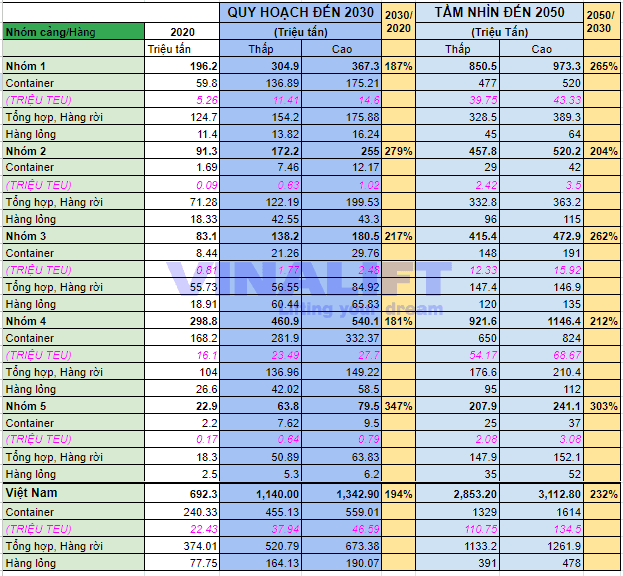
Based on the long-term plan, and specifically regarding the projected demand for container handling capacity, which is estimated to reach nearly 38 million TEUs by 2030 (exceeding Singapore’s current throughput), key projects are being gradually shaped, including:
Southeast Region with Ba Ria Vung Tau – Can Gio Gateway Port
The BRVT port cluster is being developed according to the initial plan.
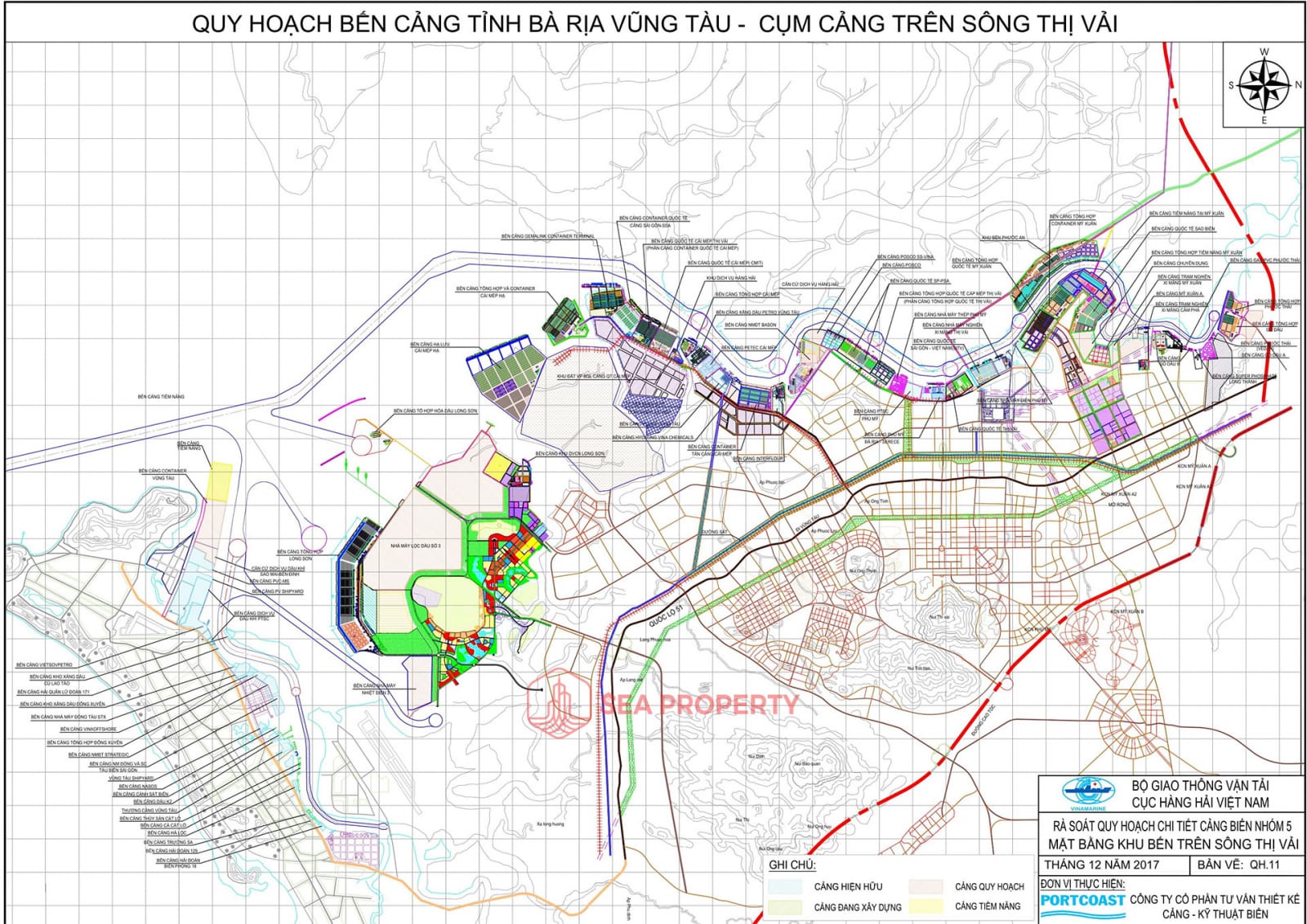
=>>> XEM THÊM: TOP 10 CẢNG BIỂN LỚN NHẤT CHÂU Á
The new design includes a deep-water port complex connecting Cai Mep Lower, downstream of the Thi Vai channel, combined with a post-port free trade zone and many other supporting services, logistics, channels, transportation corridors, and synchronous infrastructure to develop a maritime economic center for the entire Southeast region.
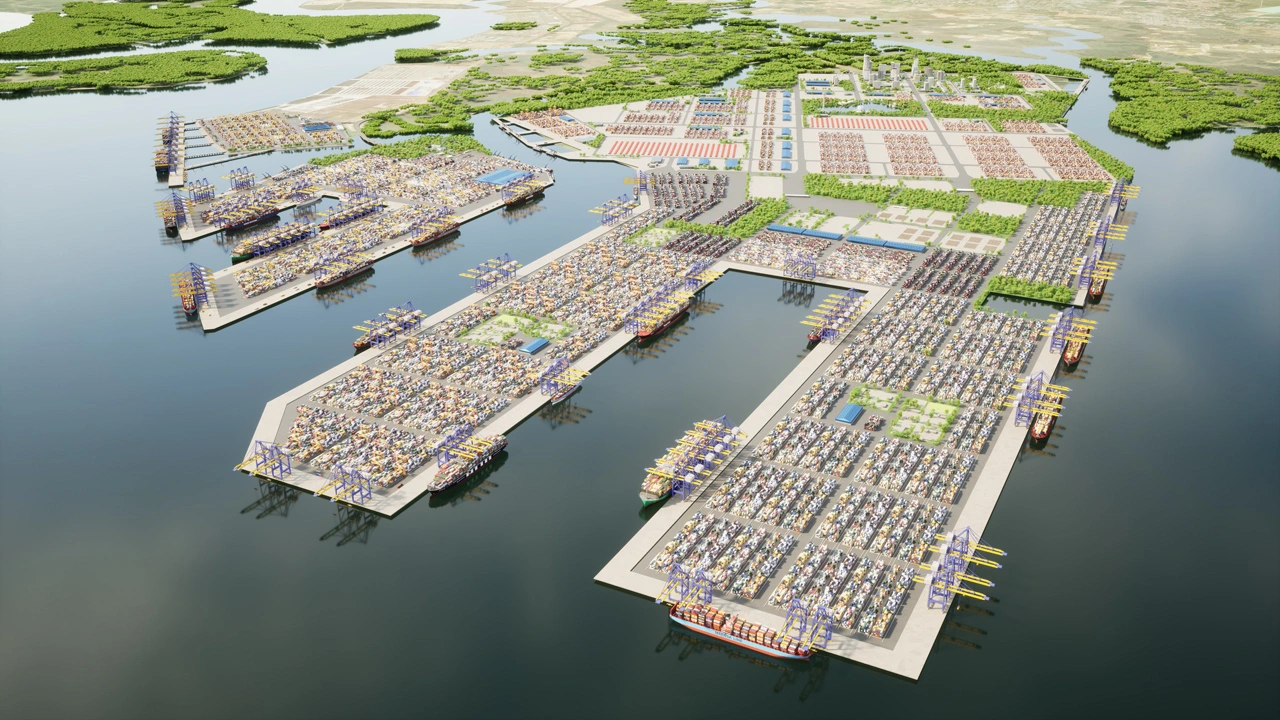
The deep-water port of Cai Mep in Ba Ria-Vung Tau has been unable to handle transshipment cargo due to fragmentation caused by the management and operation boundaries of each port and customs procedures. It is difficult to plan for multiple ships and ports to be ready to handle connecting cargo quickly for a mother vessel calling at any port.
Therefore, seaports need to prepare in advance for capacity and connectivity to attract shipping lines to provide container transshipment services. The decision to participate, compete, and develop belongs to the mother shipping lines.
Can Gio International Transshipment Port
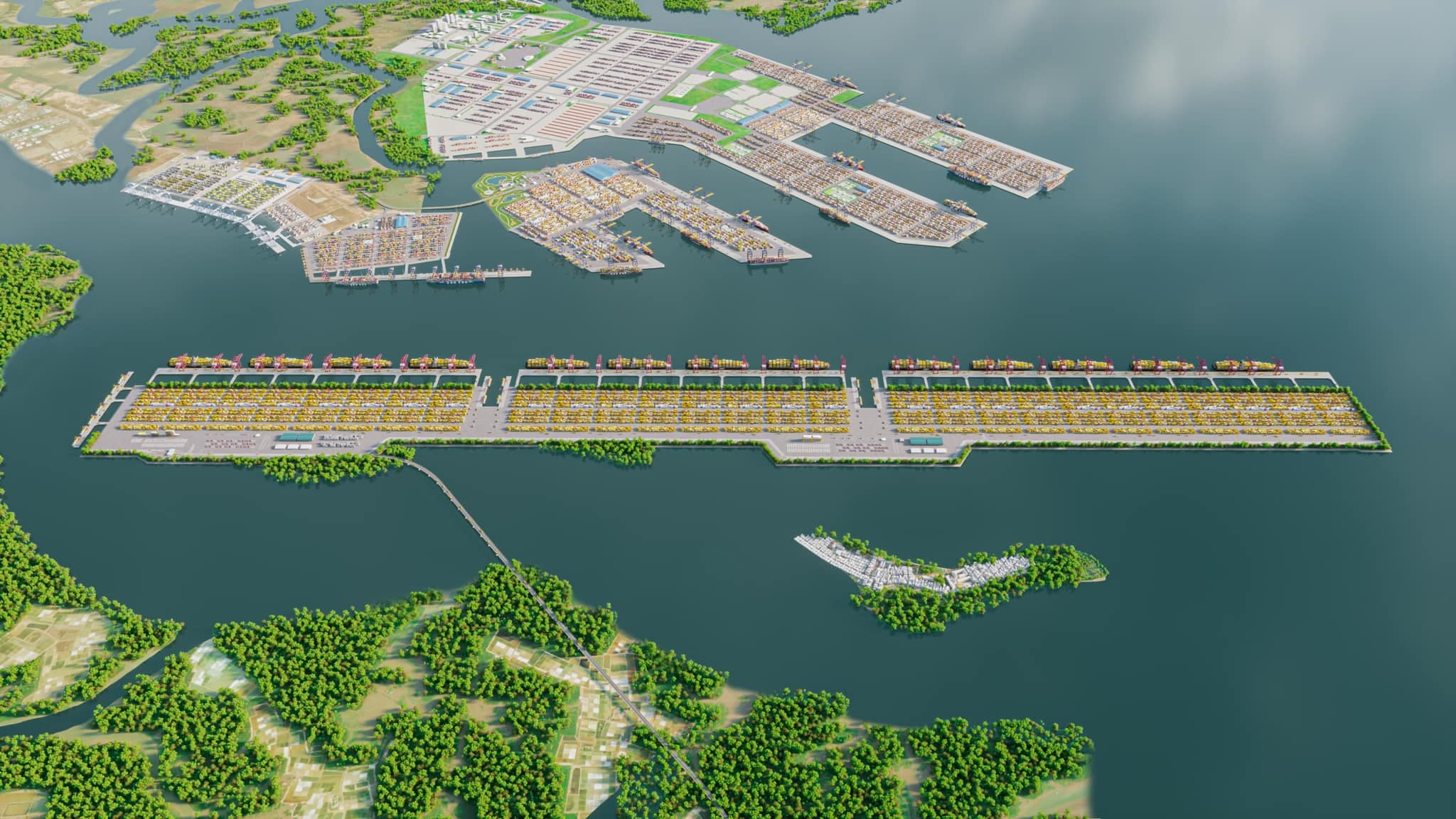
The Can Gio International Transshipment Port is expected to be located in the Con Cho area, Thach An commune, Can Gio district. The total estimated investment of the Can Gio International Transshipment Port is about 129,000 billion VND. The total length of the main wharf is expected to be about 7 km and the barge wharf is expected to be about 2 km.
The total estimated area is about 571 hectares, including wharfs, warehouses, internal transportation, office buildings, housing for operating and port exploitation personnel, technical infrastructure… about 469.5 hectares and the area of the port’s operating water is about 101.5 hectares.
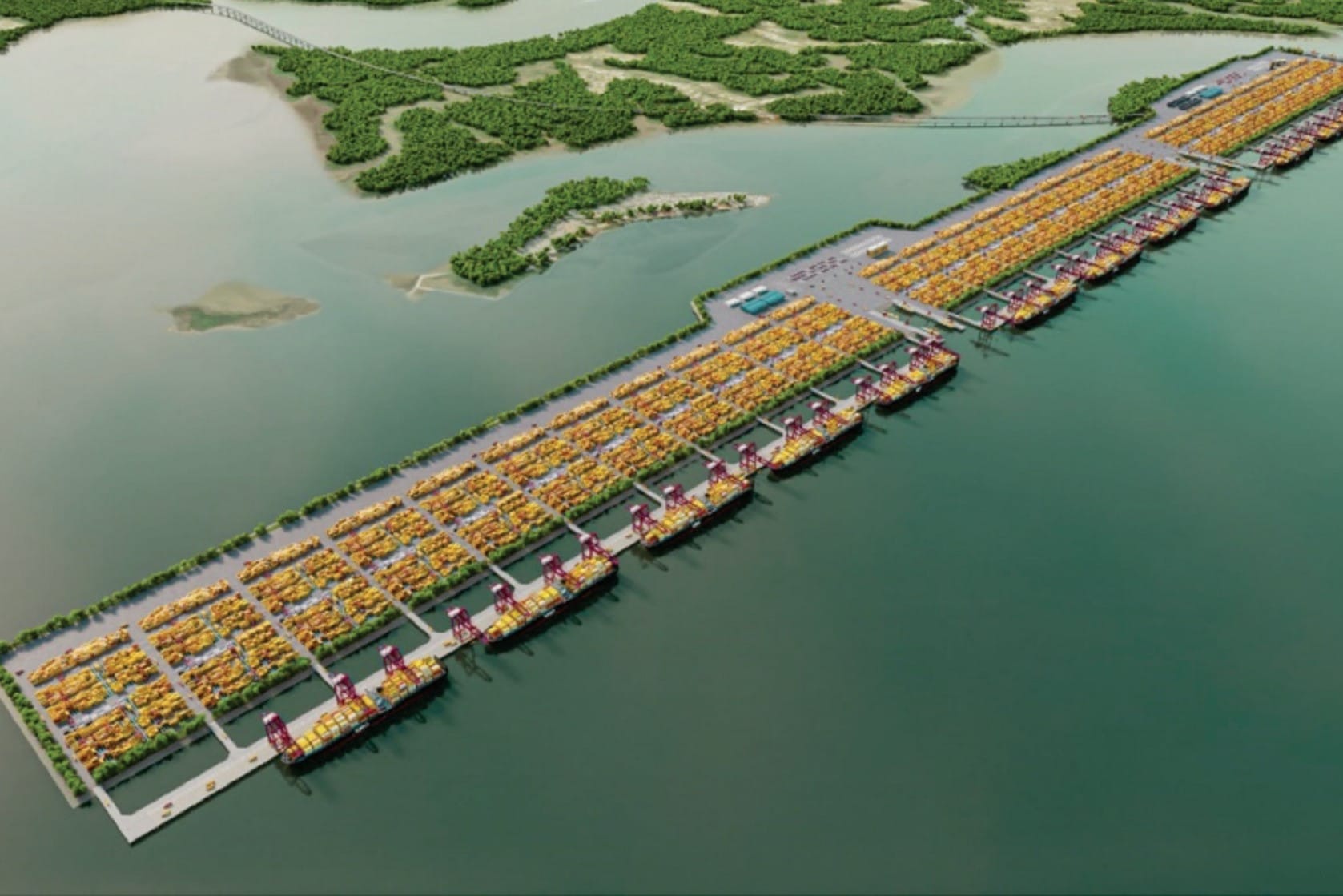
It is estimated that the annual cargo volume through the port will reach about 2.1 million TEUs (1 TEU equals 1 20-foot container) in the first year. After 7 investment phases, the cargo volume through the Can Gio International Transshipment Port can reach 16.9 million TEUs in a few years in 2047 – Equal to half of Singapore’s current output.
The port is expected to contribute to the budget of 34,000 – 40,000 billion VND per year when operating at full capacity. The total investment of the project is nearly 129,000 billion VND (5.5 billion USD), proposed by MSC Group – a top global container shipping line.
To be able to start the project in 2025 as planned, the Project on studying the construction of Can Gio International Transshipment Port must be completed soon to submit to the Prime Minister.
Lach Huyen Deepwater Port Area, Hai Phong
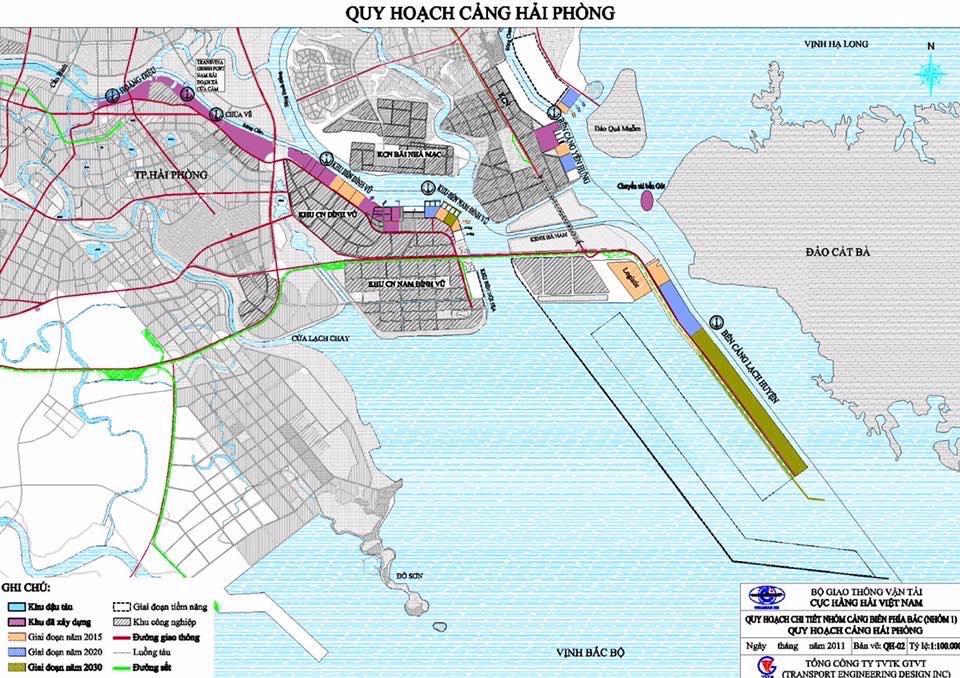
=>>> XEM THÊM: TOP 10 CẢNG BIỂN LỚN NHẤT THẾ GIỚI
Following the successful development of the Cai Mep – Thi Vai deep-water port according to the development plan for port group number 5 in the Southeast region, the Lach Huyen deep-water port cluster was also included in the development plan for port group 1 of the Hai Phong region from mid-2015.
Hai Phong International Container Port (HICT), a joint venture between Saigon Stevedoring Company and 3 foreign groups and enterprises, was built and put into operation in 2018 on an area of 44.9 hectares of land, with a depth of 16 meters in front of the wharf, a turning basin of 660 meters wide, and a channel depth of 14 meters (excluding tides) in Cat Hai town, Cat Hai district, Hai Phong city.
In the first phase, the port was invested in 2 container wharves with a total length of 750 meters, capable of receiving container ships with a capacity of 14,000 TEUs and general cargo ships with a deadweight of 160,000 DWT. The wharf and barge wharf are 150 meters long, receiving ships and barges carrying containers up to 160 TEUs. HICT is currently operating more than 12 international container shipping routes connecting Hai Phong with various markets in Asia, North America, and India… with a throughput of over 1.3 million TEUs/year.
In the new draft of Vietnam’s Seaport Development Plan, by 2025, the number of container wharves is expected to be from 5-6 wharves and 2 general wharves. By 2030, there will be 10-12 container wharves with lengths from 4,200 to 5,100 meters, 3 general wharves with a total length of 1,000 meters, capable of receiving container ships up to 12,000 TEUs and general cargo ships up to 100,000 DWT.
In the face of the developing trend in the new period, characterized by global connectivity and integration, as well as increasingly deep international competition, the Vietnamese seaport system needs management capabilities to develop regional scale, have a vision towards long-term efficiency and effectiveness, a wide scope, synchronized connectivity, and faster and more sustainable development.
Tran De Deepwater Port Project for the Mekong Delta (according to local plans)
On February 23, 2024, Soc Trang province held the 75th Standing Committee Meeting of the Provincial Party Committee to approve the pre-feasibility study report for the investment in building Tran De Port, part of Soc Trang seaport (mid-term).
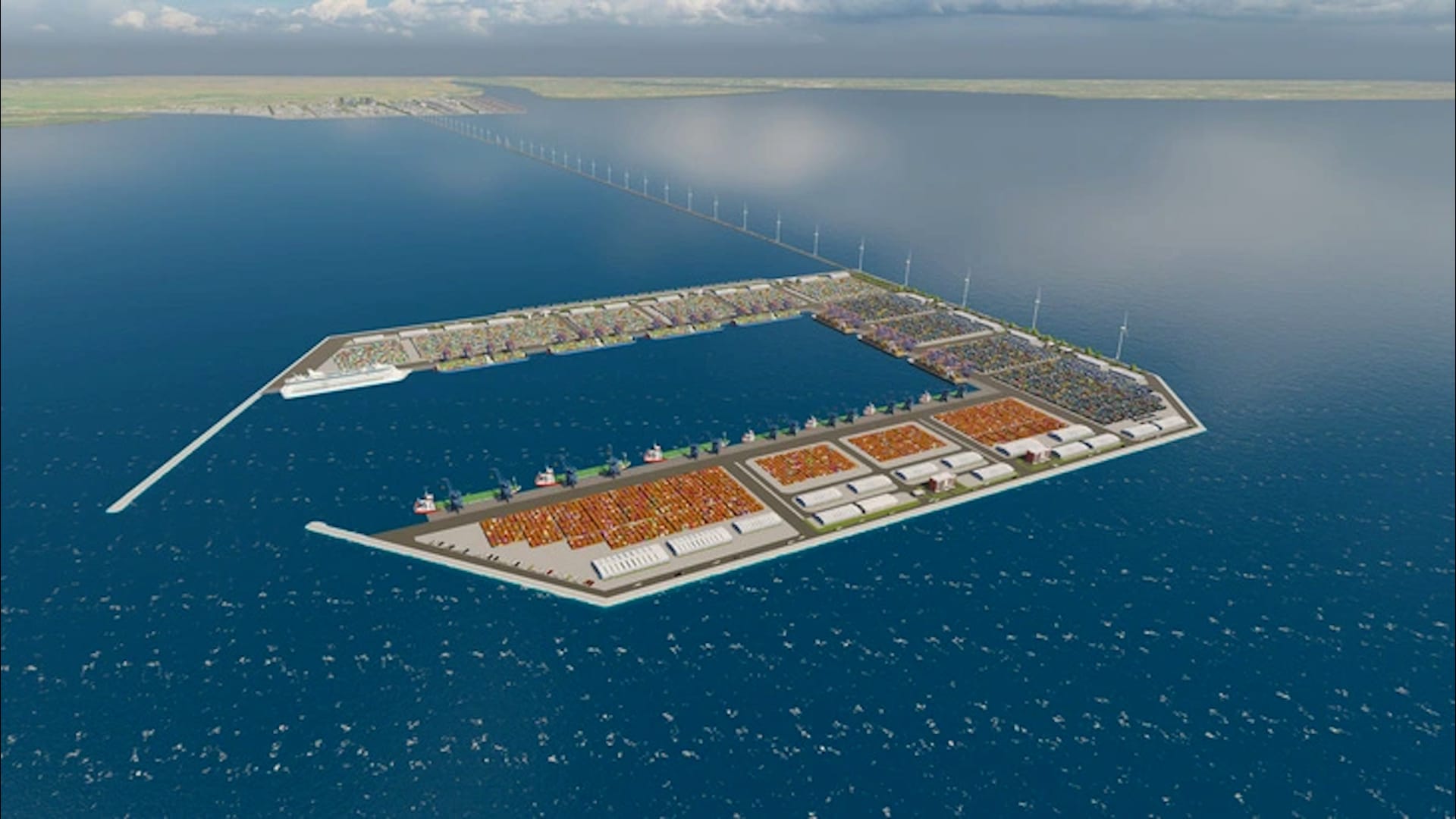
According to the consulting unit, the Tran De Port Investment Project includes two main areas: the port logistics service area located on land and the coastal area in Trung Binh commune (Tran De district, Soc Trang province) and the offshore Tran De Port located offshore Tran De, about 25 km to the east of the existing shores.
The consulting unit proposed a total planning area of 1,082 hectares by 2028 and 4,411 hectares by 2050. Of this, the offshore port is 81.6 hectares in 2028 and will be increased to 411 hectares in 2050. For the logistics service area, the consulting unit proposed an area of 1,000 hectares in 2028 and 4,000 hectares in 2050.
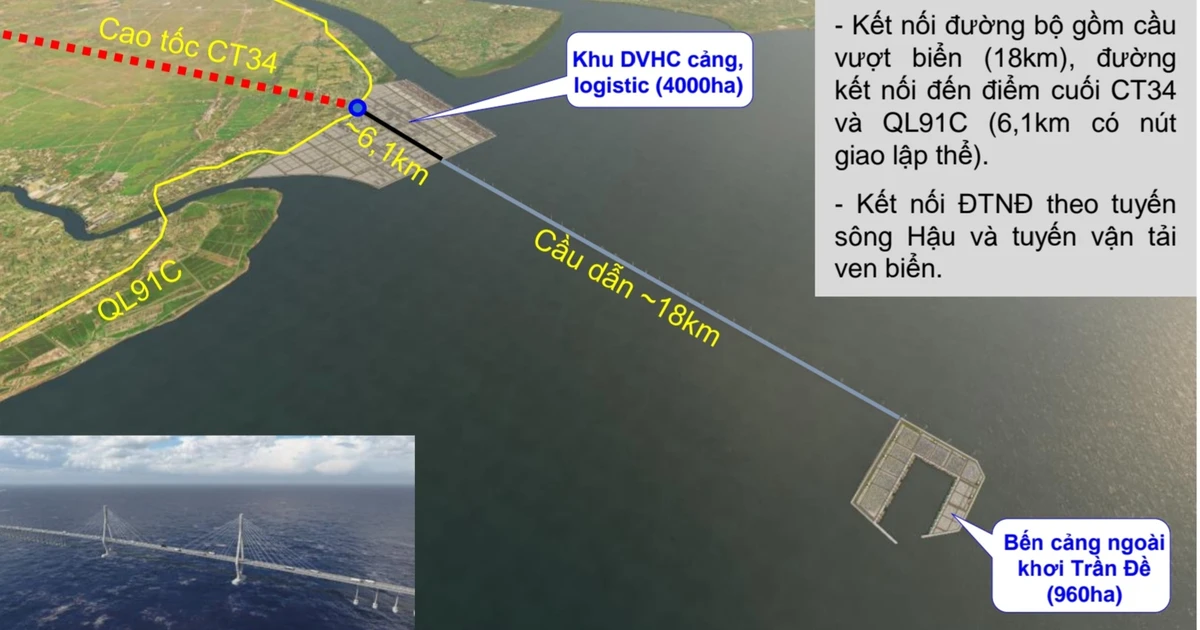
Regarding the current land use in the project area, the consulting unit believes that more than 2,568 hectares of land with coastal water, more than 942 hectares of forest protection land, and 390 hectares of aquaculture land are needed. There are also other types of land such as rural land, perennial tree planting, and annual crops…
In the initial phase (2024-2028), two wharves/800 meters will be built for general cargo ships and container ships with a deadweight of 100,000 DWT and two floating wharves for bulk cargo (coal) for ships with a deadweight of up to 160,000 DWT; building 4,000 m/9,800 m of quay/breakwater system; 1.85 km/17.8 km of overpass, access bridge connecting the overpass with the wharf; 81.6 hectares/411.25 hectares of port yard area.
In addition, dredging the area in front of the wharf, port basin, channel, turning basin, and synchronous maritime signaling system. Investing in other technical infrastructure systems, including electricity supply, water supply, drainage, fire protection, and other auxiliary works to ensure the operation of the entire port for each phase.
The estimated total investment of the project in the initial phase (2024-2028) is 44.6 billion VND, and the completion phase (2050) is nearly 162 billion VND.
Of this, the state budget capital invests in the post-port road; overpass, breakwater, channel, turning basin with total investment capital up to the completion phase of 46.476 billion VND, accounting for 29% of the total investment capital. The capital calls for investors in the remaining works and invests in port exploitation equipment with an investment capital of 116.255 billion VND, accounting for 71% of the total investment capital.
Lien Chieu Port Project in Da Nang
The Lien Chieu Port Project is planned and constructed in Hoa Hiep Bac ward, Lien Chieu district, Da Nang city. The project officially started construction in December 2022 with a total area of 450 hectares, designed with 2 components: a common infrastructure part and an investment attraction part.
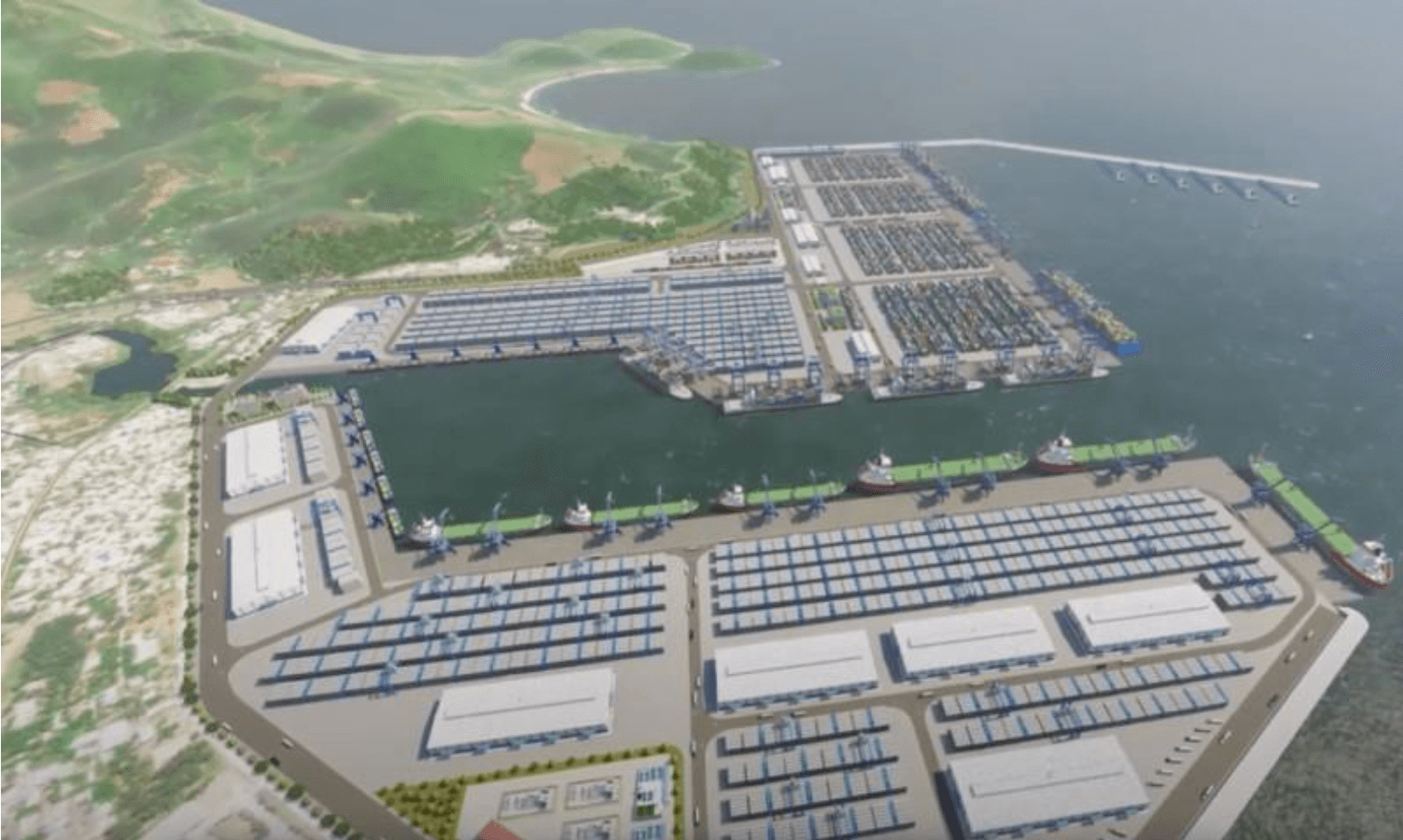
The project is divided into 3 phases: phase 1 has an area of 44.6 hectares, expected to be completed in 2025, the remaining two phases have areas of 106.81 hectares and 80.7 hectares respectively, and are expected to be completed in 2030 and 2050.
According to the plan, the common infrastructure part includes items such as channels, breakwaters over 1 km long, roads, electricity and water infrastructure… This area can accommodate general cargo ships, bulk cargo up to 100,000 tons, and container ships with a capacity of 6,000-8,000 TEUs.
According to observations, after 6 months of construction, the contractor has basically completed many auxiliary items such as a vehicle weighing station, temporary wharf, material storage yard, operation office, and dredging of the wharf foundation. Main traffic items and embankment containing dredging have reached 40% of the construction progress of the total length of foundation, base, road surface, breakwater…
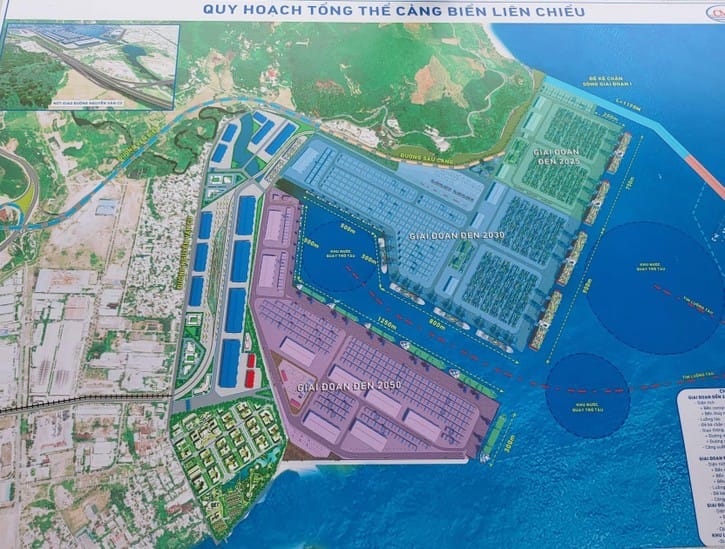
The construction of Lien Chieu port in general and the common infrastructure part has great significance in attracting investment for comprehensive port construction in the future, aiming to become an international trade gateway. It is known that on September 8, Da Nang City held the groundbreaking ceremony for the coastal road connecting Lien Chieu Port directly to the center of Da Nang City.
With a length of nearly 3 km, 6 lanes, and a speed of 60 km/h, the project will promote trade between the Lien Chieu district and the city center and surrounding areas. For workers, the road will shorten the distance to important points such as industrial parks, and Da Nang city center, saving travel time.
Not only having a significant role in the economy and national security, Lien Chieu Port is also a project with special significance in promoting investment attraction and creating favorable regional connectivity. From there, the port will become a driving force for the sustainable socioeconomic development of not only Da Nang but also the entire Central region. Lien Chieu will become an international gateway port in the Central region, becoming a transshipment point for goods of the East-West economic corridor.
Not only having a significant role in the economy and national security, Lien Chieu Port is also a project with special significance in promoting investment attraction and creating favorable regional connectivity. Lien Chieu port will become an international gateway port in the Central region, a transshipment point for goods of the East-West economic corridor, and a driving force for the sustainable socioeconomic development of not only Da Nang but also the entire Central region.
From an economic perspective, this port will lay the foundation for balancing the economic proportion of Da Nang, creating a solid “three-legged stool” when this locality can simultaneously exploit its strengths in seaport logistics economy, industrial zones, and tourism.
Bac Van Phong International Transshipment Port

The Prime Minister has just approved the Decision on general planning for the construction of the Van Phong Economic Zone, Khanh Hoa province until 2040, with a vision to 2050.
Accordingly, the Van Phong Economic Zone is a multi-sector, multi-field comprehensive economic zone playing a leading role in attracting investment and a driving force for economic development in neighboring regions and the whole country. Among them, the maritime economy is the foundation, with international container transshipment port and logistics services, urban areas, services, tourism, and industry playing important roles, combined with the development of other economic sectors.
Notably, in Van Phong Economic Zone, an international transshipment port will be built when conditions are available after 2030, capable of receiving container ships with a deadweight of up to 24,000 TEUs (250,000 tons), general cargo ships with a deadweight of up to 100,000 tons or more.
Currently, according to Vietnam’s Seaport Development Plan, detailed port groups, wharves, quays, floating docks, water areas, and water regions for the period 2021-2030, with a vision to 2050 of the Ministry of Transport submitted to the Prime Minister, Van Phong seaport is expected to be planned as an international transshipment port in the future.
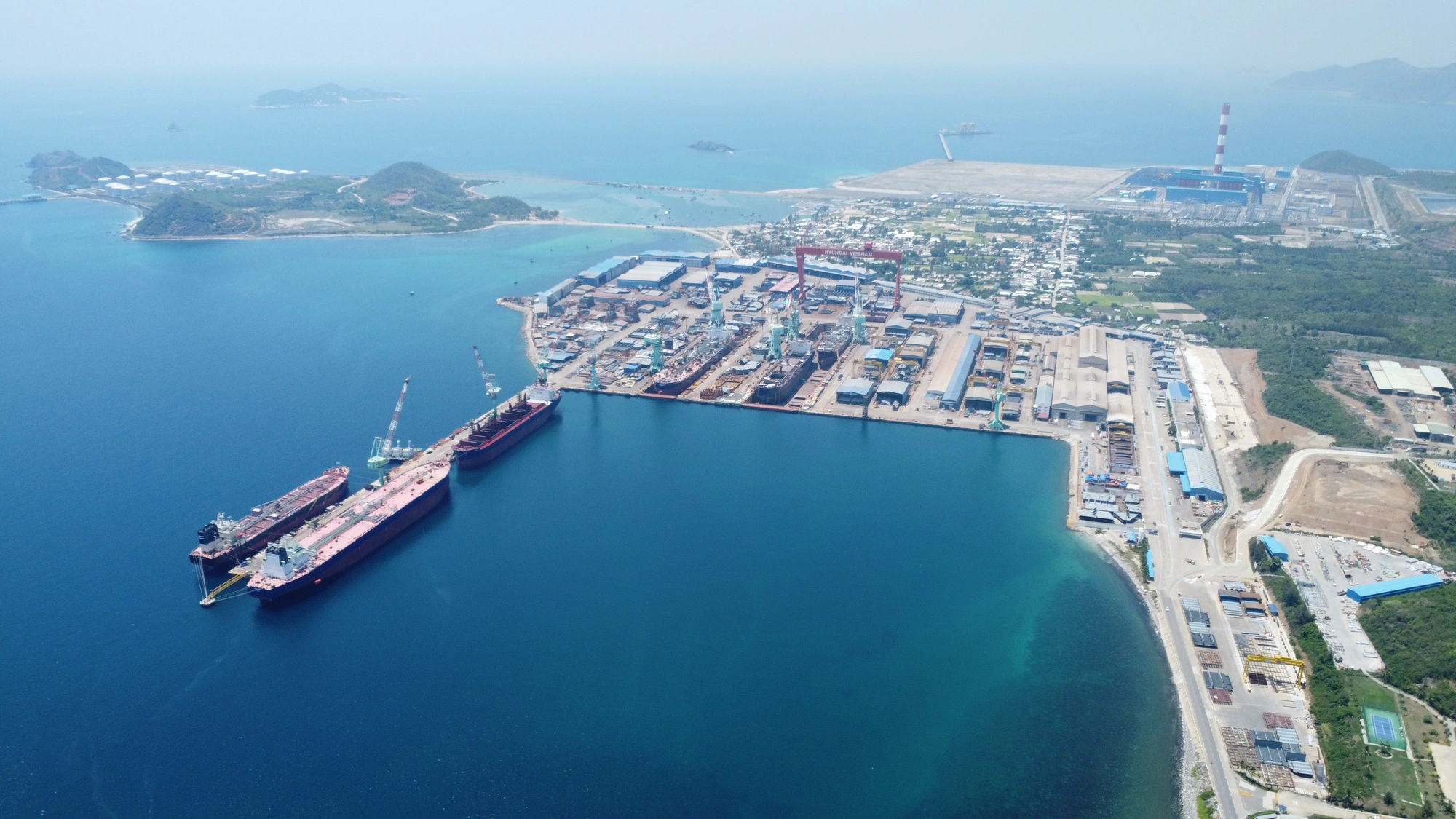
Specifically, the international transshipment port is planned in the Bac Van Phong wharf area. This wharf area will be planned with a development scale of 4 wharves with a total length of 1,041 meters, with a capacity of 4.3 to 5.4 million tons by 2025.
By 2030, the development scale will be 6 wharves with a total length of 1,831 meters, with a capacity of 5.5 to 6.9 million tons and 120,000 to 130,000 passengers.
In particular, gradually developing Bac Van Phong International Transshipment Port (Khanh Hoa), as well as international tourist passenger wharves, yacht wharves, directly serving tourists in Van Phong Bay and neighboring areas according to demand.
In the general Vietnam’s Seaport Development Plan system for the period 2021-2030 approved by the Prime Minister, it has been clearly identified that by 2030, the Bac Van Phong Wharf area has the potential to develop into an international transshipment port. This seaport has the function of serving regional economic and social development, with container wharves, general wharves, and international passenger wharves.
Other potential projects according to the general planning for the development of Vietnam’s seaport system for the period 2021-2030 (source: Vietnam Maritime Administration)
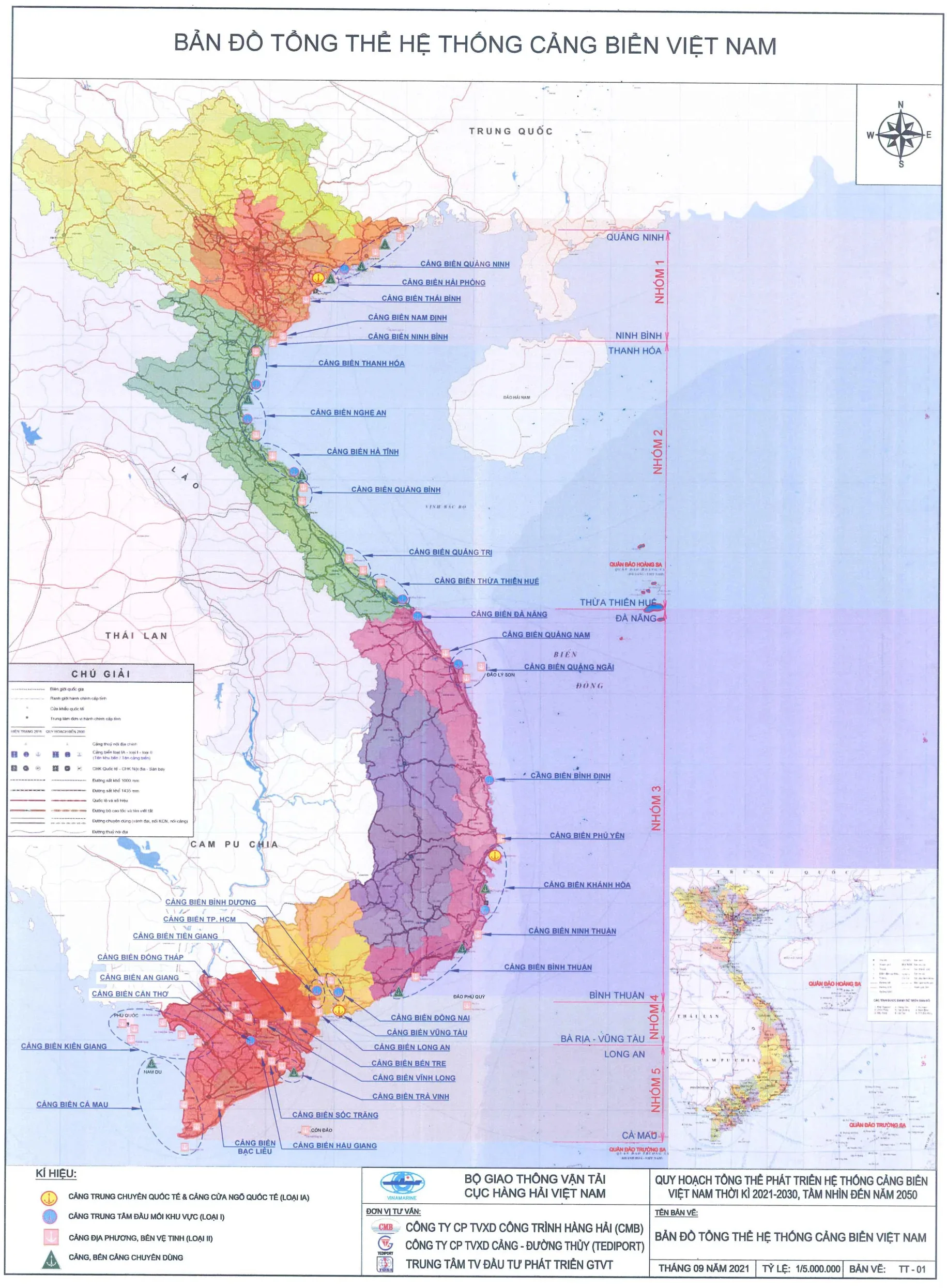
Thank you for reading this article. Please follow us on our WEBSITE or social media platforms such as FACEBOOK, LINKEDIN, and YOUTUBE for new articles with useful information.
